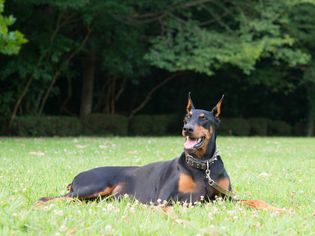Laryngeal paralysis affects the larynx, which is part of a dog's throat. The loss of muscular tone in this area affects the sounds a dog makes and hampers its ability to swallow food or breathe effortlessly. Treatment depends on the severity of the condition. Anti-inflammatory medication may help mildly affected dogs, but if a dog can't breathe, then surgery is the only remedy.
What Is Laryngeal Paralysis?
Laryngeal paralysis is a condition that affects the larynx in a dog's throat. The larynx is a cartilaginous structure that opens and closes to control airflow through the trachea (windpipe). Surrounding muscles normally work to pull the larynx open, allowing air into the lungs while breathing. They also close the larynx to block airflow when a dog is eating or drinking. In the case of laryngeal paralysis, the muscles that move the larynx become paralyzed, making it impossible for the larynx to fully open or close the trachea.
Symptoms of Laryngeal Paralysis in Dogs
The most obvious symptoms of laryngeal paralysis are audible ones that might initially sound like the dog has something caught in its throat. Signs may include:
Dogs that have developed laryngeal paralysis may sound noisy when they are breathing and panting. This is due to the cartilage of the larynx that is partially covering the opening to the airway.
The barks and other noises your dog makes may also sound different, and it could also have trouble breathing. Because it is more difficult for a dog with laryngeal paralysis to breathe, it may tire more easily and even collapse in more advanced stages of the disease.
Additionally, when a dog with laryngeal paralysis is eating, it may gag or cough due to the larynx allowing food or water to enter the trachea.
Causes of Laryngeal Paralysis in Dogs
This disease is a frustrating one for pet owners and veterinarians alike because no one knows what causes it. Labrador retrievers, golden retrievers, St. Bernards, Newfoundlands, and English setters seem to be the most commonly affected breeds, but laryngeal paralysis can also occur in any dog.
Excessive pulling against a collar or ill-fitting harness is one way a dog may develop problems with its larynx
Research indicates that there may also be a few underlying medical conditions that can increase the likelihood of developing laryngeal paralysis. These include:
- Degenerative polyneuropathy (a condition that affects not only the nerves and muscles surrounding the larynx but also nerves throughout the entire body)
- Hypothyroidism
- Cushing's disease
- Tumors
- Congenital anomalies in the anatomy of the throat
Diagnosing Laryngeal Paralysis in Dogs
A veterinarian will listen to and watch the symptoms that the dog is exhibiting to make a diagnosis of laryngeal paralysis. They may also want to look at the larynx when the dog is sedated to see whether or not it is opening and closing when the dog breathes.
A special piece of equipment called a laryngoscope is typically used to look in the back of the throat where the larynx is located. Other tests may be run to rule out other diseases or to investigate an underlying cause.
Treatment of Laryngeal Paralysis in Dogs
Surgical correction is the only treatment option for dogs with severe cases of laryngeal paralysis. A procedure is performed to permanently "tie back" one or both sides of the larynx to hold it open so that a dog can breathe.
Less severe cases may only need anti-inflammatory medications to reduce laryngeal swelling, weight loss to relieve pressure on the larynx, and restriction from exciting activities.
If laryngeal paralysis is a problem that is related to hypothyroidism or degenerative polyneuropathy, then other treatment options will be recommended by your veterinarian to address the specific underlying condition.
Prognosis for Dogs with Laryngeal Paralysis
Most dogs that suffer laryngeal paralysis can be treated and managed so that they can live semi-normal lives.
How to Prevent Laryngeal Paralysis
There is no guaranteed way to prevent laryngeal paralysis, but you can reduce the chances by not using a collar to walk or restrain your dog. Choke collars are particularly dangerous, but even normal collars can put damaging pressure on the larynx. Instead, opt for a safer harness that places more pressure against your dog's chest.








